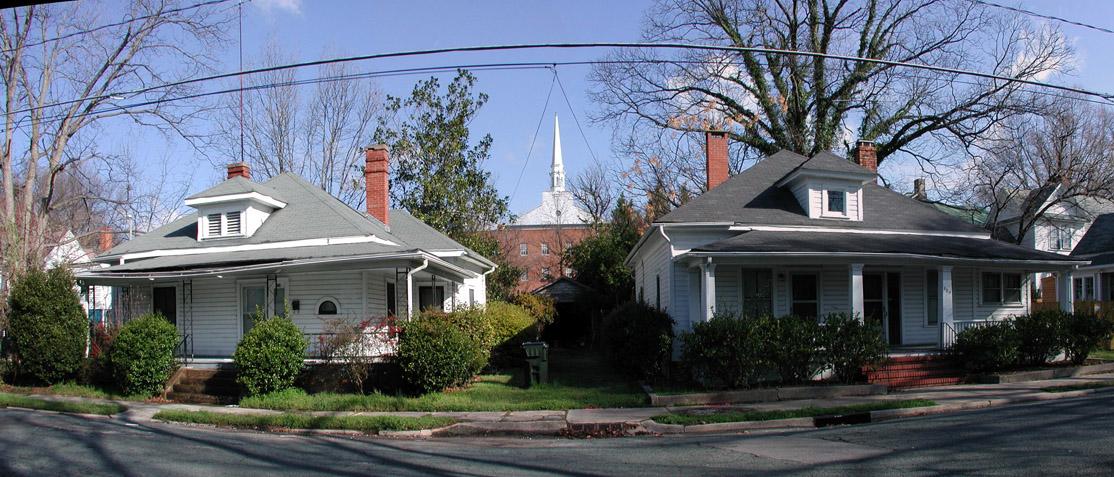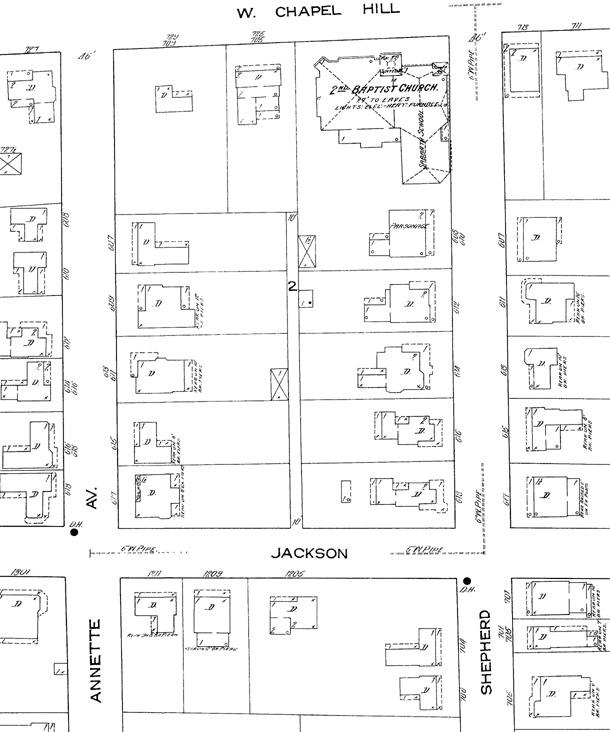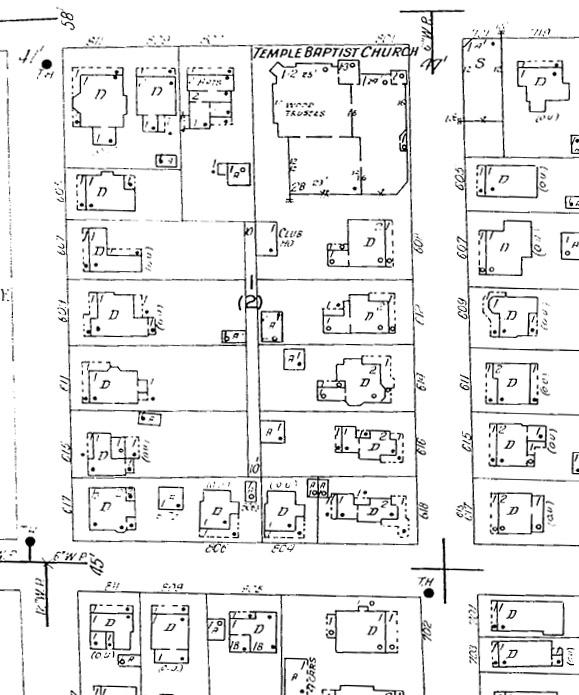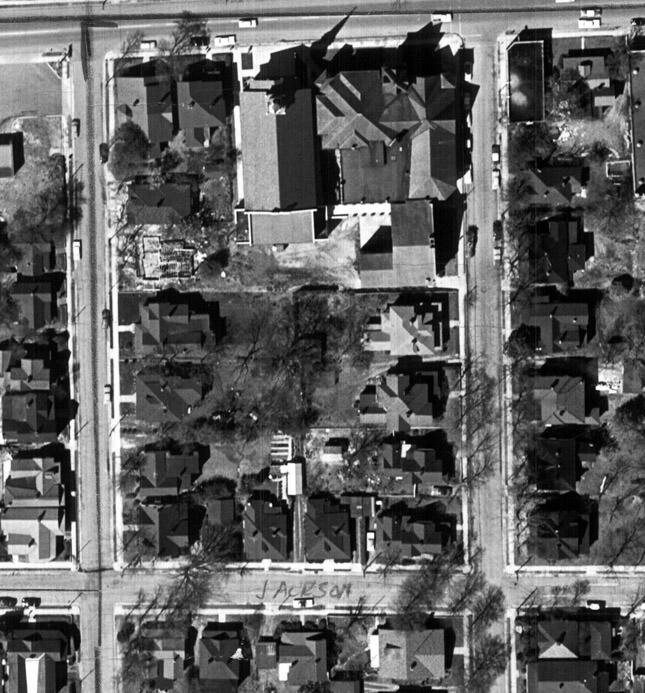804 and 806 Jackson Street, framing the steeple of the former Temple Baptist - now Healthy Start Academy, 03.16.08.
I can't tell you too much in the way of history about 804 and 806 Jackson Street. Most likely, they were built by the same builder, and they were built sometime between 1913 and, probably, about 1925. When they were built, the houses closed off the entrance to a public alleyway down the center of the block.
800 block of Jackson, 1913, prior to the houses being built.
800 block of Jackson, 1937.
You'll notice in both pictures the church, first 2nd Baptist, later Temple Baptist. I profiled this church back in 2006. Both of these Sanborn maps show the church's original sanctuary on the corner of Shepherd and West Chapel Hill St.
By the time of the below aerial photo, from 1959, the church had built a new sanctuary, in the center of the West Chapel Hill street frontage.
By the mid-to-late-1960s, the church had torn down the original sanctuary, but the church persevered here through the 70s, 80s, and 90s. In 2001, Healthy Start Academy - North Carolina's first charter school, bought the church from Temple Baptist for $2 million - the Baptist congreation continued to hold services in the new sanctuary until 2003, when they moved to the boonies.
Healthy Start has some interesting history, which you can Google and read about from the John Locke folks / Reason magazine.
As their website proudly notes, Healthy Start has received some substantial Federal grants, and appears to be financially quite successful.
And what do churches, schools, and churches-that-become-schools do when they are financially successful? They... Must... Grow.
Healthy Start seems to have acquired these parcels from Temple Baptist in a somewhat complicated arrangement that makes it unclear when they actually took control of the property. That Temple Baptist may have planned to expand this way isn't exactly surprising either - note the decrement in houses between the aerial shots above and the 2007 aerial shot, below.
800 Block of Jackson, showing property south of the current parking lot owned by Healthy Start in orange.
Healthy Start hasn't been shy about making their intentions known; evidently the director, present at the West Chapel Hill charrette, drew on her map the school taking up the remainder of the Jackson/Arnette portion of the block.
But wait, you say, isn't Morehead Hill a local historic district? And GK, you keep going on about how places like Trinity Park and Old North Durham should be local districts? They are contributing structures to the district - i.e. they had architectural and historical merit that helped make the historic district a historic district. So these houses are protected, right?
No, not really.
The big, gaping (intentional) loophole in the local historic district statute is that the Historic Preservation Commission (HPC) is not empowered to prevent demolition. The only power the HPC has is to delay demolition - for up to one year. Various conditions - such as an 'unsafe' structure or financial hardship - allow the demolisher to avoid even that delay.
Beyond that, the city attorney has recently decided that if NIS declares a structure "unsafe", then the inspections department can issue a demolition permit to an owner without them needing the HPC's approval at all. So the savvy demolisher neglects their property until it is unsafe, then can do what they want - not that NIS is exactly conservative in their declarations of what property is 'unsafe.' Turns out this is what happened over in Cleveland-Holloway to 605 Holloway.
So Healthy Start could acquire the whole block, wait a year, and then tear it all down. It could acquire the whole next block of the historic district for a high school and a football field - wait a year, and then tear it all down.
So I tend to laugh a bit when people start trotting out their property rights and distrust of gummint as reasons that they just won't accept a local district. I generally say "If you knew just how weak it was, you'd be a proponent."
Does the local district have value? Yes, of course - it usually provides for a public process, so at least the neighborhood can be aware and have a dialogue with the owner/try to find an alternative solution. It probably dissuades somebody from demo-on-a-whim, and the design criteria for new construction deter some people from thinking they can put up any-ol-piece-of-junk if they demolish.
Back to these cool little houses - the neighborhood has gone through a great deal of effort to create a local district - and there is nothing statutory that they can do to save them from Healthy Start (although one neighbor cleverly noted that the center alley still exists on the map and may remain an easement of some kind.)
The school has said that they want to expand to expand their playground - maybe so, I don't know. But it also sets up the argument a lot better than saying you need to expand the parking lot. It's pretty much the ultimate setup in the 'save-the-houses or save-the-children' dichotomy that will be argued.
People will undoubtedly argue that the school does good, you're denying children saved from falling through the cracks a place to run around, etc. It's only two houses. They aren't anything special. They aren't repairable. They have foundation problems. Etc.
But where does it stop? With the block? Then it will be a few houses in the next block for additional parking. People, including Healthy Start, moved to this neighborhood as a historic district - shouldn't they be able to rely on the district to deliver?






Comments
Submitted by nicomachus (not verified) on Thu, 3/20/2008 - 1:39pm
Yeah, but 1 Derminthians 12 clearly says, "when one is a church, one shalt expand oneself, consuming the evil and the trivial that surrounds oneself." Old houses surely are trivial (I mean, c'mon, they're all over the place in Durham) and arguably evil (especially if they stand in the way of asphalt progress).
So how d'ya 'splain that?
Local historic districts be damned.
Submitted by Tar (not verified) on Thu, 3/20/2008 - 2:26pm
The city attorney's opinion is curious. State statute and case law makes clear that the "due process" you reference requires a hearing by an HPC. The safety of the structure and such are standards for the HPC to use in determining whether the HDC can properly authorize demolition (or other alteration) in a Certificate of Appropriateness case despite there being evidence that the proposed change is not consistent (ie incongruous) with the historic characteristics of the district (or contributing structure).
Do you have any other info on how this got parlayed in Durham into skipping the HPC?
Submitted by Gary (not verified) on Thu, 3/20/2008 - 2:42pm
Nico
I slept through that part of CCD as well, evidently, but I feel the power of divinely inspired asphalt.
Tar
This is the explanation I received from Steve Cruse when I asked what penalties the city would be exacting from the owner of 605 Holloway for illegal demolition. Evidently none, for the aforementioned reasons. This issue came to a head over a battle of wills between the HPC and NIS over the push to demolish 120-122 West Main Street. NIS appeared, swaggeringly, before HPC to present the demolition, but explicitly told them that they couldn't stop NIS from demo'ing a property that was 'unsafe.' The HPC did. (As a side note, the dire condition of the property seemed to be magically alleviated for the intervening 2 years by a purchase by Greenfire and application of some green paint. Now that the deal points have been approved, the renderings show that Greenfire intends to demolish these buildings for the proposed Pickle on Parrish.)
This battle evidently spurred NIS to challenge the HPC's ability to block them. The HP statute makes an exception to the ability to delay (I don't remember the exact wording) based on the structure being structurally unsound. Based on this interpretation, evidently the city attorney found that if NIS determined it was 'unsafe', it could be torn down.
GK
Submitted by Anonymous (not verified) on Thu, 3/20/2008 - 3:07pm
Could these two homes be moved within the neighborhood to save them? Could that be made a condition by the City? The HPC?
DTD
Submitted by RWE (not verified) on Thu, 3/20/2008 - 4:43pm
Here's a link to the state legislation governing local preservation commissions:
http://www.hpo.dcr.state.nc.us/160A.htm
Here's the part that has been cited by NIS and NCCU in recent demolition requests:
"Nothing in this Part shall be construed to prevent the ordinary maintenance or repair of any exterior architectural feature in a historic district or of a landmark which does not involve a change in design, material or appearance thereof, nor to prevent the construction, reconstruction, alteration, restoration, moving or demolition of any such feature which the building inspector or similar official shall certify is required by the public safety because of an unsafe or dangerous condition."
Seems like a pretty loose interpretation to me. Is the demo of an entire structure really the same as the demo of an unsafe exterior architectural "feature"?
Submitted by Anonymous (not verified) on Fri, 3/21/2008 - 3:03pm
GK:
I believe that the City Council has the authority to authorize the HPC to prevent all demolitions in a local historic district. I'm not certain how this relates to the whole "unsafe" aspect of the process. As you posted in a previous entry, my hometown of New Bern's Board of Alderman authorized the Historic Preservation Commission to block demolitions, even beyond the 365 day mark. This authority was made available by the NC Legislature. Again, I'm not certain if this law was intended for New Bern only, or is available to all municipalities. It would be great if someone could check look into this further....
You know what brought this legislation into the spotlight? Tabernacle Baptist Church of New Bern. The Healthy Start building, once a church, now school is no different. Churches and schools do NOT make good neighbors. I agree with your point that Healthy Start came into this neighborhood knowing that this historic district was in place. If their space has been outgrown, they need to find other space somewhere else. Undermining the historic integrity of its surrounding neighborhood should be a moral issue for them, regardless of any regulations.
One may say, "oh these houses aren't anything special." No George Washington didn't spend the night there, or some robber baron didn't build his mansion there either. What did happen there, is a neighborhood. I'm speaking in context to the other, mostly modest, but well built, and architecturally interesing (in a smaller way) houses.
Having historic districts in Durham is a draw to many who live here, and consider moving here. Durham's City Council does not make historic preservation a priority when setting policy or creating expectations of its historic preservation planner. Preservation Durham, a worthwhile well intentioned preservation advocate, has not created a political grass roots will among the Durham citizenry. This will should exist and be used to guide the City towards a higher historic preservation priority.
I'd like to think Healthy Start will see it this way. I'm never hopeful when the iddy biddy little children are touted as a reason for expansion.
Myers Sugg
Submitted by Anonymous (not verified) on Fri, 3/21/2008 - 11:08pm
The Southwest central Durham Quality of Life has written letters in support of preserving these two houses and preventing the school from building a playground. The West Chapel Hill Street Economic Development Committee and the Housing Committee voted hands down in favor of complete support from SWCD QOL to Morehead Hill NA.
Everyone is focusing on these historic homes. That is and remains a part of the argument. What everyone is not talking about is the negative impact to the Morehead Hill Neighborhood. The MHNA folks did spend a lot of time getting historic registration - respect that. They also spent a lot of money on their homes; don't reduce the value by doing this? Healthy Start serves a valuable purpose, they provide a service we must have but not at the expense of the neighborhood they are a part of.
The alley is an open "paper alley". It has never, EVER had the appropriate paperwork filed to close the alley. Now you have the historic piece and the city property piece.
What about the neighbors whose property line is 10 - 20 feet from a playground (potential) that will turn into a crime area at night, increase unsafe traffic in the day, become a pick up spot for the kids and completely adversely affect the immediate and surrounding neighbors and their right to quiet enjoyment. This is historic, but it also the community, and the community with full support from its six neighboring community's, Duke and the businesses on Chapel Hill Street are against this in favor of Morehead Hill.
Jeff
Submitted by john Martin (not verified) on Sun, 3/23/2008 - 4:09pm
Hey Gary,
Do you have any idea when ANnette become ARnette, or did the 1913 Sanford map just misspell the street name?
John
Submitted by Gary (not verified) on Sun, 3/23/2008 - 9:39pm
John
I think it's a spelling error - other maps seem to have "Arnette" as the consistent spelling. Nice pickup - I didn't even notice.
GK
Submitted by Anonymous (not verified) on Mon, 3/24/2008 - 12:06pm
Maybe Bill Fields could be persuaded to fix up and sell at a low price the Medical Arts building to the school. Plenty of room for expansion there.
Submitted by Gary (not verified) on Mon, 3/24/2008 - 12:11pm
That would be great - I'd throw in Sturdivant's Urban Merchant Center (the old Holiday Inn), too. It's already got the school buses.
GK
Submitted by Anonymous (not verified) on Mon, 3/24/2008 - 3:59pm
Another thing is that Healthy Start bought these two structures some time ago with the intent of letting them fall apart to a level that they could be considered unsafe. They were lived in up until several years ago.
How neighborly, honest, and ethical is that?
(I've often thought that perhaps concerned Durhamites could start a "guerilla restoration movement" and go around fixing up structures in the middle of the night so that they won't be considered unsafe and an eyesore. A coat of paint, some potted flowers on the porch, and a few other fixes, and bam! It'd look to purdy to tear down...)
Submitted by Anonymous (not verified) on Fri, 7/11/2008 - 2:28pm
Please sign the petition to save these historic Jackson street homes.
http://www.ipetitions.com/petition/savejacksonsthomes/
Submitted by Elizabeth Sapp… (not verified) on Mon, 9/8/2008 - 8:53pm
@ Myers
New Bern and several other towns have had enabling legislation passed by the General Assembly that allow them to have different demo delay regulations. All NC Historic District Commissions are regulated by the state's enabling legislation that rwe linked to. By going back to the General Assembly and getting new enabling legislation, they are allowed to pass local laws that are an exception. The New Bern legislation is specific only to New Bern, but several other towns have done the same thing. For example, Apex got their enabling legislation and then passed a law enabling demolition delay for historic structures without having to set up an HDC. There is a really good report on Apex's legislation/ordinance prepared by Cary's planning staff for their Council to consider.
http://www.townofcary.org/pd/pl07-025.htm
To get similar enabling legislation passed in the GA requires nearly unanimous support from the City Council. They must make it clear that the legislation is a priority for them. Then the Council would have to pass the local ordinance that sets up the new delay mechanism.
Submitted by JenSwen (not verified) on Fri, 10/2/2009 - 2:44pm
Does anyone know the policies behind all the current tear-downs in the Morehead Hill-Lakewood border area? (Carroll St., Buchanan)- they are happening so fast in the last year, that I'm expecting to see solid rows of little vinyl-sided porches replacing all houses soon! While I realize that not many want to restore some of these very dilapidated structures, the current rate of tear down and volunteer-build up is astounding.
Add new comment
Log in or register to post comments.